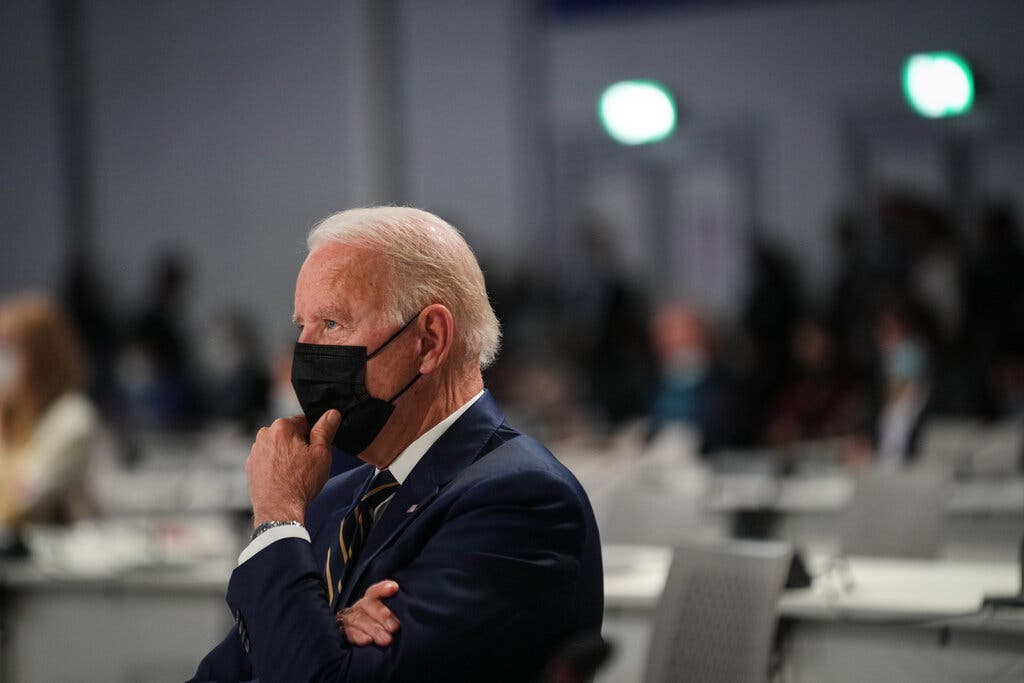
President Biden at the opening session of the COP26 summit on Monday. Mr. Biden said that 70 countries had joined a coalition to cut methane levels 30 percent by 2030: Erin Schaff/The New York Times
Staff Report –
WASHINGTON, D.C. – The Biden administration says the United States will for the first time heavily regulate the potent greenhouse gas methane, which leaks from oil and natural gas platforms and is a significant source of air pollution that is contributing to warming the atmosphere 80 times as fast as carbon dioxide, research shows.
The Environmental Protection Agency made the announcement on Tuesday as the president is in Glasgow, Scotland for the United Nations climate summit, where he is trying to persuade other countries to reduce emissions from fossil fuels that are heating the planet to dangerous levels. The EPA intends to limit the methane coming from approximately one million existing oil and gas rigs across the country.
“As global leaders convene at this pivotal moment in Glasgow … it is now abundantly clear that America is back and leading by example in confronting the climate crisis with bold ambition,” EPA Administrator Michael S. Regan said in the announcement.
“With this historic action, EPA is addressing existing sources from the oil and natural gas industry nationwide, in addition to updating rules for new sources, to ensure robust and lasting cuts in pollution across the country,” he said. “By building on existing technologies and encouraging innovative new solutions, we are committed to a durable final rule that is anchored in science and the law, that protects communities living near oil and natural gas facilities, and that advances our nation’s climate goals under the Paris Agreement.”
The federal government previously implemented some rules during the Obama administration in the attempt to prevent methane leaks from oil and gas wells built since 2015, but they were rolled back by the Trump administration. Biden intends to restore and strengthen them, sources said.
“The methane announcement comes as Mr. Biden faces intense pressure both internationally and at home to show that the United States, the nation that has pumped the most greenhouse gases into the atmosphere, is serious about mitigating climate change,” according to New York Times coverage of the story.
The EPA is billing the move as an important step forward to advance President Biden’s commitment to action on climate change and protect people’s health by proposing comprehensive new protections to sharply reduce pollution from the oil and natural gas industry – including, for the first time, reductions from existing sources of methane pollution nationwide.
“The proposed new Clean Air Act rule would lead to significant, cost-effective reductions in methane emissions and other health-harming air pollutants that endanger nearby communities,” the agency says in the press release.
One third of the warming from greenhouse gases occurring today is due to human-caused emissions of methane, a potent greenhouse gas that traps about 30 times as much heat as carbon dioxide over 100 years. Sharp cuts over the next decade will have a near-term beneficial impact on the climate, the EPA contents.
In the U.S., the oil and natural gas industry is the largest industrial source of methane emissions, emitting more methane than the total emissions of all greenhouse gases from 164 countries combined. Oil and natural gas operations also emit smog-forming volatile organic compounds (VOCs) and toxic air pollutants such as benzene that harm public health.
The proposal builds on the work of leading companies that are using the latest cost-effective technology to reduce methane emissions in the field and leverages lessons from the work of some major oil- and gas- producing states that require, or are proposing to require, oil and gas operations to reduce methane emissions. EPA analyzed the proposed rule’s impact on natural gas and oil prices from 2023 to 2035 and estimates that changes would be small – pennies per barrel of oil or thousand cubic feet of gas.
The proposed rule would reduce 41 million tons of methane emissions from 2023 to 2035, the equivalent of 920 million metric tons of carbon dioxide. That’s more than the amount of carbon dioxide emitted from all U.S. passenger cars and commercial aircraft in 2019. In 2030 alone, the rule would reduce methane emissions from sources covered in the proposal by 74 percent compared to 2005.
Pollution from oil and gas activities can occur in or near communities where people live, work and go to school – including minority and low-income communities, which are especially vulnerable to the effects of climate change. Based on an analysis of populations exposed to oil and gas pollution, EPA believes the proposed rule is likely to reduce these harmful effects.
EPA’s Regulatory Impact Analysis estimates the value of cumulative net climate benefits from the proposed rule, after taking into account the costs of compliance as well as savings from recovered natural gas, is $48 to $49 billion from 2023 to 2035 - the equivalent of about $4.5 billion a year. The climate benefits are estimated using the social cost of greenhouse gases and represent the monetary value of avoided climate damages associated with a decrease in emissions of a greenhouse gas.
In addition to these benefits, EPA estimates that from 2023 to 2025, the proposal would reduce VOC emissions by 12 million tons and hazardous air pollution by 480,000 tons.
It would accomplish this through updated and broadened methane and VOC emission reduction requirements for new, modified, and reconstructed oil and gas sources, including standards that limit emissions from additional types of sources, such as intermittent vent pneumatic controllers, associated gas, and well liquids unloading for the first time under the Clean Air Act. The requirements that states develop plans to limit methane emissions from hundreds of thousands of existing sources nationwide will also help, along with presumptive standards for existing sources to assist in the planning process.
The agency is seeking comment on additional sources of methane to further strengthen emission controls and increase reductions from oil and gas operations, and is issuing the proposal in response to President Biden’s Executive Order on Protecting Public Health and the Environment and Restoring Science to Tackle the Climate Crisis.
Key features of the proposed rule include:
* A comprehensive monitoring program for new and existing well sites and compressor stations;
* A compliance option that allows owners and operators the flexibility to use advanced technology that can find major leaks more rapidly and at lower cost than ever before;
* A zero-emissions standard for new and existing pneumatic controllers (with a limited alternative standard for sites in Alaska), certain types of which account for approximately 30 percent of current methane emissions from the oil and natural gas sector;
* Standards to eliminate venting of associated gas, and require capture and sale of gas where a sales line is available, at new and existing oil wells;
* Proposed performance standards and presumptive standards for other new and existing sources, including storage tanks, pneumatic pumps, and compressors; and
* A requirement that states meaningfully engage with overburdened and underserved communities, among other stakeholders, in developing state plans.
The EPA also is requesting information on additional sources of methane for the Agency to consider in developing a supplemental proposal to reduce emissions even further. In addition, EPA is taking comment on how to structure a community monitoring program that would empower the public to detect and report large emission events for appropriate follow-up by owners and operators for possible further development in a supplemental proposal. The agency intends to issue the supplemental proposal in 2022, and to issue a final rule before the end of 2022.
As it developed the rule, the EPA conducted extensive public outreach to hear from the public and diverse perspectives including states, Tribal nations, communities affected by oil and gas pollution, environmental and public health organizations, and representatives of the oil and natural gas industry, all of which provided ideas and information that helped shape and inform the proposal.
EPA will take comment on the proposed rule for 60 days after it is published in the Federal Register. The Agency also will hold a virtual public hearing, and will host virtual trainings to help communities, Tribes and small businesses learn more about the proposed rule and participating in the public comment process. Those trainings begin November 16.
For more information on today’s proposed rule and to register to attend a training, visit the relevant section of the agency’s website here.
___
If you support truth in reporting with no paywall, and fearless writing with no popup ads or sponsored content, consider making a contribution today with GoFundMe or Patreon or PayPal.













